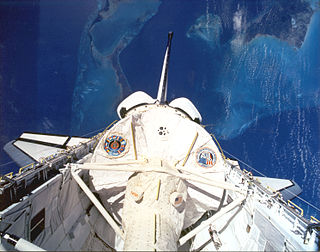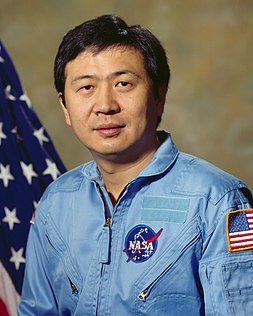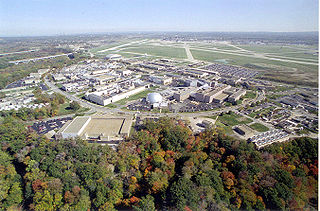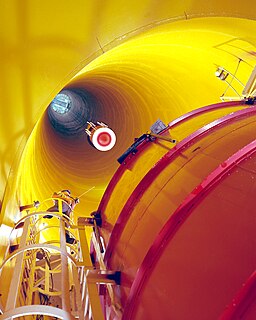Related Research Articles

STS-50 was a NASA Space Shuttle mission, the 12th mission of the Columbia orbiter. Columbia landed at Kennedy Space Center for the first time ever due to bad weather at Edwards Air Force Base caused by the remnants of Hurricane Darby.

Taylor Gun-Jin Wang is a Chinese-born American scientist and in 1985, became the first person of Chinese origin to go into space. While an employee of the Jet Propulsion Laboratory, Wang was a payload specialist on the Space Shuttle Challenger mission STS-51-B.

NASA John H. Glenn Research Center at Lewis Field is a NASA center within the cities of Brook Park and Cleveland between Cleveland Hopkins International Airport and the Rocky River Reservation of Cleveland Metroparks, with a subsidiary facility in Sandusky, Ohio. Its acting director is James A. Kenyon. Glenn Research Center is one of ten major NASA facilities, whose primary mission is to develop science and technology for use in aeronautics and space. As of May 2012, it employed about 1,650 civil servants and 1,850 support contractors on or near its site.

STS-42 was a NASA Space Shuttle Discovery mission with the Spacelab module. Liftoff was originally scheduled for 8:45 EST on 22 January 1992, but the launch was delayed due to weather constraints. Discovery successfully lifted off an hour later at 9:52:33 EST. The main goal of the mission was to study the effects of microgravity on a variety of organisms. The shuttle landed at 8:07:17 PST on 30 January 1992 on Runway 22, Edwards Air Force Base, California. STS-42 was the first of two flights in 1992 of Discovery, the second of which occurred during STS-53, which launched on 2 December 1992. The mission was also the last mission of the Space Shuttle Discovery to have a seven-member crew until STS-82, which was launched on 11 February 1997.

A reduced-gravity aircraft is a type of fixed-wing aircraft that provides brief near-weightless environments for training astronauts, conducting research and making gravity-free movie shots.

STS-69 was a Space Shuttle Endeavour mission, and the second flight of the Wake Shield Facility (WSF). The mission launched from Kennedy Space Center, Florida on 7 September 1995. It was the 100th successful crewed NASA spaceflight, not including X-15 flights.

STS-87 was a Space Shuttle mission launched from Launch Complex 39B of the Kennedy Space Center on 19 November 1997. It was the 88th flight of the Space Shuttle and the 24th flight of Columbia. The mission goals were to conduct experiments using the United States Microgravity Payload (USMP-4), conduct two EVAs, and deploy the SPARTAN-201 experiment. This mission marked the first time an EVA was performed from Columbia. An EVA from Columbia was originally planned for STS-5 in 1982 but was canceled due to spacesuit problems. It also marked the first EVA conducted by a Japanese astronaut, Takao Doi.

Skylab 3 was the second crewed mission to the first American space station, Skylab. The mission began on July 28, 1973, with the launch of NASA astronauts Alan Bean, Owen Garriott, and Jack Lousma in the Apollo command and service module on the Saturn IB rocket, and lasted 59 days, 11 hours and 9 minutes. A total of 1,084.7 astronaut-utilization hours were tallied by the Skylab 3 crew performing scientific experiments in the areas of medical activities, solar observations, Earth resources, and other experiments.

Space Station Freedom was a NASA project to construct a permanently crewed Earth-orbiting space station in the 1980s. Although approved by then-president Ronald Reagan and announced in the 1984 State of the Union address, Freedom was never constructed or completed as originally designed, and after several cutbacks, the project evolved into the International Space Station program.
In physics and materials science, a drop tower or drop tube is a structure used to produce a controlled period of weightlessness for an object under study. Air bags, polystyrene pellets, and magnetic or mechanical brakes are sometimes used to arrest the fall of the experimental payload. In other cases, high-speed impact with a substrate at the bottom of the tower is an intentional part of the experimental protocol.
Microgravity University, also known as the Reduced Gravity Student Flight Opportunities Program (RGSFOP) was a program run by NASA which enables undergraduate university students to perform microgravity experiments aboard NASA's reduced-gravity DC-9 aircraft at Johnson Space Center in Houston, Texas.

The Zero Gravity Research Facility at the NASA Glenn Research Center in Cleveland, Ohio is a unique facility designed to perform tests in a reduced gravity environment. It has successfully supported research for the United States crewed spacecraft programs and numerous uncrewed projects. The facility uses vertical drop tests in a vacuum chamber to investigate the behavior of components, systems, liquids, gases, and combustion in such circumstances.

Weightlessness is the complete or near-complete absence of the sensation of weight. It is also termed zero G-force or zero-G.

The International Space Station is a platform for scientific research that requires one or more of the unusual conditions present in low Earth orbit. The primary fields of research include human research, space medicine, life sciences, physical sciences, astronomy and meteorology. The 2005 NASA Authorization Act designated the American segment of the International Space Station as a national laboratory with the goal of increasing the use of the ISS by other federal agencies and the private sector.

The Combustion Integrated Rack (CIR) is an experiment facility installed in the International Space Station (ISS). It includes an optics bench, combustion chamber, fuel and oxidizer control, and five different cameras for performing combustion experiments in microgravity.
ELIPS - European Programme for Life and Physical Sciences in Space and applications utilising the International Space Station started in 2001 and was intended to cover the activities for the following 5 years. This Microgravity Programme at the European Space Agency (ESA) is an optional programme, with currently 17 ESA member states participating. The ELIPS programme prepares and performs research on the International Space Station, and other unmanned mission platforms like Sounding Rockets, in fundamental and applied life and physical sciences. ELIPS is the continuation of the earlier European microgravity programmes EMIR 1&2, and the Microgravity Facilities for Columbus, MFC.

The NASA Launch Services Program (LSP) is responsible for procurement of launch services for NASA uncrewed missions and oversight of launch integration and launch preparation activity, providing added quality and mission assurance to meet program objectives. LSP operates under the NASA Space Operations Mission Directorate (SOMD).

Vladimir Pletser is Visiting Professor – Scientific Adviser at the Technology and Engineering Centre for Space Utilization (CSU) of the Chinese Academy of Sciences in Beijing, China, since April 2016. He supports the preparation of scientific experiments in microgravity for the future Chinese Space Station and for aircraft parabolic flights. He worked previously from 1985 till early 2016 as senior Physicist-Engineer at the European Space Research and Technology Centre (ESTEC) of ESA.

Astronaut training describes the complex process of preparing astronauts in regions around the world for their space missions before, during and after the flight, which includes medical tests, physical training, extra-vehicular activity (EVA) training, procedure training, rehabilitation process, as well as training on experiments they will accomplish during their stay in space.

Made In Space, Inc. (MIS) is an American company specializing in the engineering and manufacturing of three-dimensional printers for use in microgravity. Headquartered in Jacksonville, Florida, Made In Space's 3D printer was the first manufacturing device used in space.